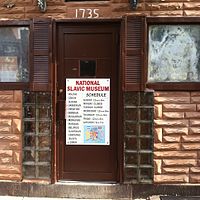History of Russians in Baltimore
The history of the Russians in Baltimore dates back to the mid-19th century. The Russian community is a growing population and constitutes a major source of new immigrants to the city. Historically the Russian community was centered in East Baltimore, but most Russians now live in Northwest Baltimore's Arlington neighborhood and in Baltimore's suburb of Pikesville.[1]
Demographics
During the 1990s around 8,208 immigrants settled in Baltimore from Russia, Ukraine, and other countries of the former Soviet Union.[1]
The Russian community in the Baltimore metropolitan area numbered 35,763 as of 2000, making up 1.4% of the area's population.[2] Russian-Americans are the largest foreign-born groups in Baltimore.[3] 19,430 Russians live in adjacent Baltimore County and in total 7.2% of the Baltimore metropolitan area's foreign-born population is Russian-American.[4]
According to the 2000 Census, the Russian language was spoken at home by 1,235 people in Baltimore.[5]
As of 2005, Baltimore had the 15th-largest Russian-speaking population in the United States.[6]
As of September 2014, immigrants from Russia were the twenty-sixth largest foreign-born population in Baltimore.[7]
History

Most Russian immigrants to Baltimore have been Russian Jews. In the 1930 United States Census there were 17,000 Russians living in the city, most of whom were Jewish.[8] In comparison to Baltimore's wealthy and assimilated German Jews, the Russian Jews were largely poor and lived in slums with other Russians. The German-Russian divide among Baltimore's Jewry lead many Jews from Russia to associate more with the Russian community than the wider Jewish community. Baltimore's Russian community, including the Russian Jews, was originally centered in Southeast Baltimore.[9] The largest wave of Russian-Jewish immigrants to Baltimore occurred during the 1880s. A second wave of Russian-Jewish immigrants came during the 1990s, following the collapse of the Soviet Union.[10]
In the 1960 United States Census, Russian Jews comprised 18.2% of Baltimore's population. By 1940, Russian Jews were the majority in 13 of Baltimore's census tracts.[11]
Russian Jews helped establish several synagogues in Baltimore, including the B'nai Israel Synagogue[12] and the Shaarei Tfiloh Synagogue.[13]
While most people of Russian descent in Baltimore are Jewish, a significant minority are Christians, mostly from the Russian Orthodox Church. Ethnic Russians from Belarus established the Transfiguration of our Lord Russian Orthodox Church in 1963 in order to serve the needs of the Russian Orthodox community. Russian Orthodox Christians also established the Holy Trinity Russian Orthodox Church.
To facilitate the integration of Russian immigrants into American society, the Baltimore branch of the HIAS established a bilingual Russian-English newspaper titled The News Exchange in May, 1978.[14]
In the 1990 United States Census over 30,000 people of Russian descent lived in Baltimore and Baltimore County. At the time, over 400 Russian-speaking people settled in the Baltimore area each year.[15]
Ze Mean Bean Café in Fell's Point opened in 1995. It is a restaurant which offers Russian cuisine, as well as other Slavic and Eastern European fare.[16]
Culture

In 1995 a biweekly Russian language newspaper titled Kaskad (Cascade) was founded by a Russian-speaking Jewish immigrant from Belarus.[6][15]
As of 1995, the Baltimore area was home to several Russian grocery stores, a Russian language magazine, and a Russian language radio program.[15]
An annual Russian Festival is held at the Holy Trinity Russian Orthodox Church in October. The festival celebrates Russian heritage, history, and cuisine.[17]
The National Slavic Museum opened in 2012. The museum focuses on the Slavic history of Baltimore, including Baltimore's Russian history.[18]
Notable Russian-Americans from Baltimore

See also
References
- ^ a b "Foreign Immigration". Maryland Department of Planning. Retrieved 2014-07-09.
- ^ "Table DP-1. Profile of General Demographic Characteristics: 2000" (PDF). 2000 United States Census. Retrieved 2014-02-13.
- ^ "Moscow Nights: Getting Down With Baltimore's Burgeoning Eastern Bloc". Baltimore City Paper.
{{cite web}}: Italic or bold markup not allowed in:|publisher=(help) - ^ "`I feel myself at home here': The region's thousands of Russian immigrants are thriving". The Baltimore Sun. Retrieved 2014-02-13.
{{cite web}}: Italic or bold markup not allowed in:|publisher=(help) - ^ "Immigration and the 2010 Census Governor's 2010 CensusOutreach Initiatives" (PDF). Maryland State Data Center. Retrieved 2014-03-31.
- ^ a b "`I feel myself at home here'". The Baltimore Sun. Retrieved 2014-07-09.
{{cite web}}: Italic or bold markup not allowed in:|publisher=(help) - ^ "The Role of Immigrants in Growing Baltimore: Recommendations to Retain and Attract New Americans" (PDF). WBAL-TV. Retrieved 2014-10-31.
{{cite web}}: line feed character in|title=at position 26 (help) - ^ American Guide Series (1940). Maryland: A Guide to the Old Line State. United States: Federal Writers' Project. OCLC 814094.
- ^ Hill, Jayme Rae (2008). From the Brothel to the Block: Politics and Prostitution in Baltimore During the Progressive Era. Baltimore, Maryland: University of Maryland, Baltimore County. pp. 33–4. OCLC 434829400. Retrieved February 13, 2014.
- ^ "DiverCity: From Russian With Love". Baltimore Magazine.
{{cite web}}: Italic or bold markup not allowed in:|publisher=(help) - ^ Durr, Kenneth D. (2003). Behind the Backlash: White Working-Class Politics in Baltimore, 1940-1980. Chapel Hill, North Carolina: University of North Carolina Press. p. 225. ISBN 0-8078-2764-9. Retrieved February 13, 2014.
- ^ Fred Shoken. "A History of the B'nai Israel Congregation of Baltimore City". Retrieved February 13, 2014.
- ^ "Maryland Historical Trust". Shaarei Tfiloh Synagogue, Baltimore City. Maryland Historical Trust. 2014-02-13.
- ^ Waxman, Chaim Isaac (1983). America's Jews in Transition. Philadelphia, Pennsylvania: Temple University Press. p. 194. ISBN 0-877-22321-1. Retrieved February 14, 2014.
- ^ a b c "A Way To 'Defend Our Culture'". The Baltimore Sun. Retrieved 2014-07-09.
{{cite web}}: Italic or bold markup not allowed in:|publisher=(help) - ^ "Baltimore's Favorite Old World Restaurant Debuts Hot New Look Inspired by Three Generations of Family-Owned Ze Mean Bean Café". Marketwired. Retrieved 2014-08-12.
- ^ "Best Russian Foods In Baltimore". CBS Baltimore. Retrieved 2014-07-09.
{{cite web}}: Italic or bold markup not allowed in:|publisher=(help) - ^ Pamela Wood (June 16, 2013). "Slavic heritage celebrated at museum dedication". The Baltimore Sun. Retrieved 2014-10-31.
